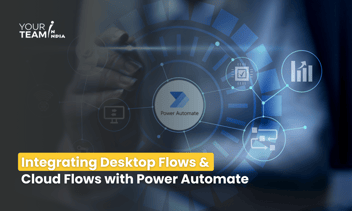Quick Summary: This comprehensive guide will help you dive into the world of cloud flow automation in Power Automate. Learn how to trigger one cloud flow from another, enabling seamless integration and orchestration of automated processes for enhanced efficiency and productivity.
Introduction
In the realm of automation, Power Automate stands out as a robust tool, empowering users to create workflows that enhance productivity and efficiency. Leveraging its capabilities to trigger one cloud flow from another opens doors to seamless integration and enhanced automation strategies. In this article, we'll delve into the process of triggering one cloud flow from another in Power Automate, exploring its significance and providing a step-by-step guide for implementation.
Understanding Cloud Flows in Power Automate
Cloud flows, built on web browsers, are the building blocks of automation in Power Automate. They represent a sequence of actions or steps executed when a specific trigger occurs. They enable users to automate tasks across various applications and services, simplifying complex workflows and reducing manual intervention.
Significance of Triggering One Cloud Flow from Another
The ability to trigger one cloud flow from another is instrumental in orchestrating intricate automation scenarios. It allows for:
-
Seamless Workflow Integration:
-
Modular Automation:
Divide complex processes into manageable segments, enabling easier management and scalability.
-
Enhanced Automation Capabilities:
Build more sophisticated automation scenarios by chaining together multiple cloud flows.
Ready to supercharge your business processes with Power Automate?
Hire our skilled Power Automate developers to automate workflows and boost efficiency.
Steps to Trigger One Cloud Flow from Another
Create Child Flow
Create a new Cloud flow: Click on "Create", choose "Automated Cloud flow”.
- Select a Trigger: Define the trigger that initiates the first cloud flow.choose When an HTTP request is received.
Configure the trigger by choosing the Method; depending on your requirement, it can either Get or Post. Provide the JSON schema in the trigger. This trigger automatically generates an HTTP URL, which we will use in our parent flow to trigger this flow. We can pass parameters in this URL to pass data between two flows and use them.
- Create Initial Flow
- Log in to Power Automate: Access your Power Automate account and navigate to the dashboard.
- Create a New Cloud Flow: Click on "Create" and choose "Automated Cloud Flow" or "Instant Cloud Flow," depending on your workflow requirements.
- Select a Trigger: Define the trigger that initiates the first cloud flow. This could be an event like "When an item is created" in SharePoint or "When a new email arrives" in Outlook.
- Add Actions: Include the necessary actions that follow the trigger event within the flow. These actions could involve sending emails, updating records, or any other relevant task.
- You need to add a URL or API endpoint in the flow in one of the actions.
- Save and Test: Save the flow and run it to ensure that it performs the intended actions accurately.
Best Practices
Consistent Naming Conventions
Maintaining a uniform naming convention for flows and actions is essential for clarity and organization within Power Automate. Consistency facilitates easier identification and management of workflows, especially when dealing with multiple flows. Consider the following tips:
- Descriptive Names: Use names that accurately describe the flow's purpose or function. For instance, "Approval Process—Sales Orders" or "Notification—Inventory Update."
- Standardized Formats: Establish a standardized format or structure for naming flows and actions across the organization. This might include prefixes or suffixes denoting the flow type or related department.
- Avoid Ambiguity: Ensure names are clear and unambiguous, avoiding abbreviations or acronyms that might be confusing to others who aren't familiar with the specific context.
Use of Control Actions:
Control actions like "Condition," "Scope," "Apply to Each," and "Switch" play a pivotal role in managing the flow's logic and handling diverse scenarios efficiently:
- Condition: Use conditional statements to create branching logic based on specific criteria. For instance, route the flow differently based on the value of a field or the presence of certain data.
- Scope: Employ scope actions to group related actions together, aiding in organization and readability of the flow. Scopes also help handle errors by isolating sections of the flow.
- Apply to Each: When dealing with arrays or multiple items, the "Apply to Each" action is invaluable. It allows actions to be performed iteratively for each item in the array.
- Switch: Implement switch cases when dealing with multiple possible outcomes, providing a structured way to handle various scenarios within the flow.
Security and Permissions:
Ensuring proper security measures and permissions are set for flows is critical, particularly when triggering one flow from another:
- Role-Based Access Control (RBAC): Leverage RBAC mechanisms to assign appropriate permissions to individuals or groups. This prevents unauthorized access to sensitive data or critical functionalities within flows.
- Data Encryption: Where sensitive data is involved, encryption methods are used to protect data both at rest and in transit, ensuring it remains secure throughout the flow process.
- Authentication and Authorization: Integrate authentication protocols like OAuth or Azure Active Directory to ensure that only authenticated users or applications can trigger or interact with the flows.
Conclusion
Triggering one cloud flow from another in Power Automate amplifies the platform's automation capabilities, allowing for the creation of more sophisticated and integrated workflows. By following the outlined steps and adhering to best practices, users can seamlessly orchestrate multiple flows, streamline processes, and unlock the full potential of automation within their organizations.
The ability to interconnect workflows optimizes efficiency and lays the groundwork for scalable and adaptable automation strategies, empowering businesses to thrive in an increasingly digital landscape.
Hire Power Automate developers to automate workflows, boost efficiency, and unlock your organization's full potential. Let's transform your operations together!







